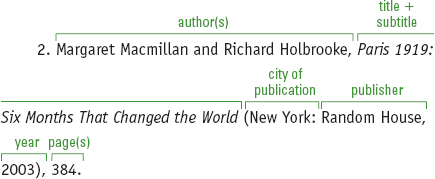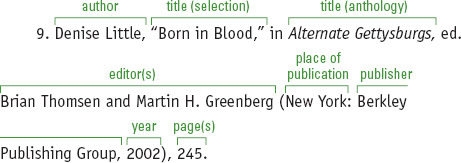Print and digital books
For the basic format for citing a print book, see the source map on pp. 504–5. The note for a book typically includes five elements: author’s name, title and subtitle, city of publication and publisher, year, and page number(s) or electronic locator information for the information in the note. The bibliographic entry usually includes all but the page number (and does include a URL or other locator if the book is digitally published), but it is styled differently: commas separate major elements of a note, but a bibliographic entry uses periods.
1. one author

Painter, Nell Irvin. The History of White People. New York: W. W. Norton, 2010.
2. multiple authors

Macmillan, Margaret, and Richard Holbrooke. Paris 1919: Six Months That Changed the World. New York: Random House, 2003.
With more than three authors, you may give the first-listed author followed by et al. in the note. In the bibliography, list all of the authors’ names.
2. Stephen J. Blank et al., Conflict, Culture, and History: Regional Dimensions (Miami: University Press of the Pacific, 2002), 276.
Blank, Stephen J., Lawrence E. Grinter, Karl P. Magyar, Lewis B. Ware, and Bynum E. Weathers. Conflict, Culture, and History: Regional Dimensions. Miami: University Press of the Pacific, 2002.
3. organization as author

World Intellectual Property Organization. Intellectual Property Profile of the Least Developed Countries. Geneva: World Intellectual Property Organization, 2002.
4. unknown author
4. Broad Stripes and Bright Stars (Kansas City, MO: Andrews McMeel, 2002), 10.
Broad Stripes and Bright Stars. Kansas City, MO: Andrews McMeel, 2002.
5. online book
5. Dorothy Richardson, Long Day: The Story of a New York Working Girl, as Told by Herself (1906; UMDL Texts, 2010), 159, http://quod.lib.umich.edu/cgi/t/text/text-idx?c=moa;idno=AFS7156.0001.001.
Richardson, Dorothy. Long Day: The Story of a New York Working Girl, as Told by Herself. 1906. UMDL Texts, 2010. http://quod.lib.umich.edu/cgi/t/text/text-idx?c=moa;idno=AFS7156.0001.001.
6. electronic book (e-book)
6. Manal M. Omar, Barefoot in Baghdad (Naperville, IL: Sourcebooks, 2010), Kindle edition, ch. 4.
Omar, Manal M. Barefoot in Baghdad. Naperville, IL: Sourcebooks, 2010. Kindle edition.
7. edited book with no author
7. James H. Fetzer, ed., The Great Zapruder Film Hoax: Deceit and Deception in the Death of JFK (Chicago: Open Court, 2003), 56.
Fetzer, James H., ed. The Great Zapruder Film Hoax: Deceit and Deception in the Death of JFK. Chicago: Open Court, 2003.
8. edited book with author
8. Leopold von Ranke, The Theory and Practice of History, ed. Georg G. Iggers (New York: Routledge, 2010), 135.
von Ranke, Leopold. The Theory and Practice of History. Edited by Georg G. Iggers. New York: Routledge, 2010.
9. selection in an anthology or chapter in a book with an editor

Give the inclusive page numbers of the selection or chapter in the bibliographic entry.
Little, Denise. “Born in Blood.” In Alternate Gettysburgs. Edited by Brian Thomsen and Martin H. Greenberg, 242–55. New York: Berkley Publishing Group, 2002.
10. introduction, preface, foreword, or afterword
10. Robert B. Reich, introduction to Making Work Pay: America after Welfare, ed. Robert Kuttner (New York: New Press, 2002), xvi.
Reich, Robert B. Introduction to Making Work Pay: America after Welfare, vii–xvii. Edited by Robert Kuttner. New York: New Press, 2002.
11. translation
11. Suetonius, The Twelve Caesars, trans. Robert Graves (London: Penguin Classics, 1989), 202.
Suetonius. The Twelve Caesars. Translated by Robert Graves. London: Penguin Classics, 1989.
12. edition other than the first
12. Dee Brown, Bury My Heart at Wounded Knee: An Indian History of the American West, 4th ed. (New York: Owl Books, 2007), 12.
Brown, Dee. Bury My Heart at Wounded Knee: An Indian History of the American West, 4th ed. New York: Owl Books, 2007.
13. multivolume work
13. John Watson, Annals of Philadelphia and Pennsylvania in the Olden Time, vol. 2 (Washington, DC: Ross & Perry, 2003), 514.
Watson, John. Annals of Philadelphia and Pennsylvania in the Olden Time. Vol. 2. Washington, DC: Ross & Perry, 2003.
14. reference work. In a note, use s.v., the abbreviation for the Latin sub verbo (“under the word”), to help your reader find the entry. Do not list reference works such as encyclopedias or dictionaries in your bibliography.
14. Encyclopedia Britannica, s.v. “carpetbagger.”
15. work with a title within the title. Use quotation marks around any title within a book title.
15. John A. Alford, A Companion to “Piers Plowman” (Berkeley: University of California Press, 1988), 195.
Alford, John A. A Companion to “Piers Plowman.” Berkeley: University of California Press, 1988.
16. sacred text. Do not include sacred texts in the bibliography.
16. Luke 18:24–25 (New International Version)
16. Qur’an 7:40–41
17. source quoted in another source. Identify both the original and the secondary source.
17. Frank D. Millet, “The Filipino Leaders,” Harper’s Weekly, March 11, 1899, quoted in Richard Slotkin, Gunfighter Nation: The Myth of the Frontier in Twentieth-Century America (New York: HarperCollins, 1992), 110.
Millet, Frank D. “The Filipino Leaders.” Harper’s Weekly, March 11, 1899. Quoted in Richard Slotkin, Gunfighter Nation: The Myth of the Frontier in Twentieth-Century America (New York: HarperCollins, 1992), 110.